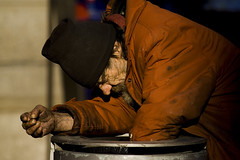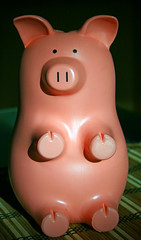
When people are forced into a financial hardship, like being homeless, they often survive only by making the best of their situation, no mater how bleak it is. This humbling experience can also illustrate the value of money, or lack of it, in a crystal clear manner. If only the average consumer looked at their finances like a homeless person trying to survive, they would probably be better off.
For simplicity lets take a look at the value of $5.00.Scenario 1:
While walking by the corner store, one sweltering hot day, Trevor decided to buy a soda. Unfortunately the clerk only accepted cash, but pointed him to the ATM located in back. On the way to the ATM, Trevor noticed a water fountain by the bathrooms, but he decided the soda sounded more refreshing. After accepting the $2.50 ATM fee, he withdrew $20.00 and returned to the counter to buy the $2.50 soda. He stepped outside took a big gulp and continued his walk hardly skipping a beat.
Scenario 2:
Perry was laid off a while back, and has been without adequate income for a while. He sleeps under a bridge, and can't remember the last time he changed his clothes. He walks 2 miles everyday to the corner of Main street and Union to beg for change. Today it happens to be raining. Perry stands in his regular spot with a cardboard sign in one hand, and holds his garbage bag poncho over his head with the other. Since most drivers don't want to roll down their window in the rain, Perry only receives a handful spare change, and a few dollar bills. After standing on the corner for a couple of hours, he counts his earnings which total $5.00. He staggers into a grocery store to buy breakfast. He first walks into the bathroom to wash his hands, and to fill his water bottle from the sink. He then proceeds to gather his items: A banana for $0.59, an orange for $0.67, a loaf of day old bread for $0.99, a can of tuna for $0.99, a can of stew for $1.29. The total at the checkout counter is $4.94 including the 9% sales tax. It is a familiar total, and leaves him with $0.06 to save for later. Outside he sits against the wall of the building, and eats his fruit. He patiently looks forward to the tuna sandwiches for lunch, and the stew for dinner. Any day that Perry gets to eat is a good one.
The amount spent is exactly the same in both scenarios the only difference is the the way each person perceives money. In the first scenario Trevor chooses soda over water without giving it a second thought. While in the second scenario, Perry stands in the rain for hours for the same amount of money. Five dollars has a much different value in each of their hands. It is too bad that Trevor does not spend money as frugally as Perry, because Trevor owes 22k in credit card debt, while Perry has positive net worth of $0.06.
 Everyone is talking about the new "Cash for Clunkers" bill, but becareful or you might be sorry. The Cash for Clunkers voucher is great if you are already looking to buy a new car. It’s important to remember that getting a good deal on a new car doesn’t automatically mean that you can afford it.
Everyone is talking about the new "Cash for Clunkers" bill, but becareful or you might be sorry. The Cash for Clunkers voucher is great if you are already looking to buy a new car. It’s important to remember that getting a good deal on a new car doesn’t automatically mean that you can afford it.














